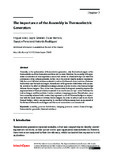Mostrar el registro sencillo del ítem
The importance of the assembly in thermoelectric generators
| dc.creator | Araiz Vega, Miguel | es_ES |
| dc.creator | Catalán Ros, Leyre | es_ES |
| dc.creator | Herrero Mola, Óscar | es_ES |
| dc.creator | Pérez Artieda, Miren Gurutze | es_ES |
| dc.creator | Rodríguez García, Antonio | es_ES |
| dc.date.accessioned | 2020-11-09T09:47:47Z | |
| dc.date.available | 2020-11-09T09:47:47Z | |
| dc.date.issued | 2018 | |
| dc.identifier.isbn | 978-1-78923-440-4 (Print) | |
| dc.identifier.isbn | 978-1-78923-441-1 (Electronic) | |
| dc.identifier.uri | https://hdl.handle.net/2454/38574 | |
| dc.description.abstract | Generally, in the optimization of thermoelectric generators, only the heat exchangers or the thermoelectric modules themselves are taken into account. However, the assembly of the generator as a whole is of vital importance since a bad contact or a thermal bridge can waste the performance of an optimal generator. In this sense, the present chapter analyzes experimentally the use of different interface materials to reduce the thermal contact resistance between the modules and the heat exchangers, the influence of the pressure distribution in the assembly as well as the effect of different insulating materials in order to reduce the thermal bridge between the exchangers. Thus, it has been demonstrated that a good assembly requires the implementation of thermal interface materials to ensure the microscopic contact between the heat exchangers and the modules, besides a uniform clamping pressure. Nevertheless, since this is normally achieved with screws, they represent a source of thermal bridges in conjunction with the small distance between the exchangers. In order to reduce heat losses due to thermal bridges, which can represent up to one-third of the incoming heat, an increment of the distance between the exchangers and the use of an insulator is recommended. | en |
| dc.description.sponsorship | The authors are indebted to the Ministry of Economy, Industry and CompetitivenessGovernment of Spain and FEDER Funds for economic support of this work, included in the DPI2014-53158-R Research Project, as well as to the FPU Program of the Spanish Ministry of Education, Culture and Sport (FPU16/05203). | en |
| dc.format.extent | 22 p. | |
| dc.format.mimetype | application/pdf | en |
| dc.language.iso | eng | en |
| dc.publisher | IntechOpen | en |
| dc.relation.ispartof | Patricia Aranguren (editor): Bringing thermoelectricity into reality. London: IntechOpen, 2018. Print ISBN: 978-1-78923-440-4; eISBN: 978-1-83881-565-3. doi: 10.5772/intechopen.71354 | en |
| dc.rights | © 2018 The Author(s). Licensee IntechOpen. This chapter is distributed under the terms of the Creative Commons Attribution license, which permits unrestricted use and reproduction in any medium, provided the original work is properly cited. | en |
| dc.rights.uri | http://creativecommons.org/licenses/by/3.0/ | |
| dc.subject | Assembly | en |
| dc.subject | Pressure distribution | en |
| dc.subject | Clamping pressure | en |
| dc.subject | Contact | en |
| dc.subject | Thermal bridge | en |
| dc.subject | Thermoelectric generator | en |
| dc.subject | Thermal resistance | en |
| dc.title | The importance of the assembly in thermoelectric generators | en |
| dc.type | Capítulo de libro / Liburuen kapitulua | es |
| dc.type | info:eu-repo/semantics/bookPart | en |
| dc.contributor.department | Ingeniería | es_ES |
| dc.contributor.department | Ingeniaritza | eu |
| dc.contributor.department | Institute of Smart Cities - ISC | es_ES |
| dc.rights.accessRights | Acceso abierto / Sarbide irekia | es |
| dc.rights.accessRights | info:eu-repo/semantics/openAccess | en |
| dc.identifier.doi | 10.5772/intechopen.75697 | |
| dc.relation.projectID | info:eu-repo/grantAgreement/MINECO//DPI2014-53158-R/ES/ | en |
| dc.relation.publisherversion | https://doi.org/10.5772/intechopen.75697 | |
| dc.type.version | Versión publicada / Argitaratu den bertsioa | es |
| dc.type.version | Versión publicada / Argitaratu den bertsioa | es |



